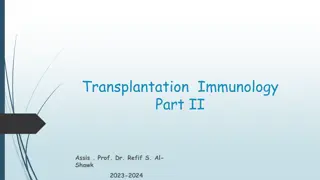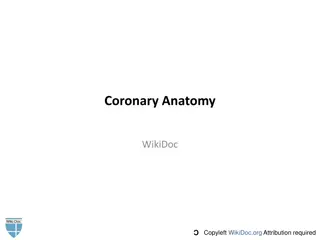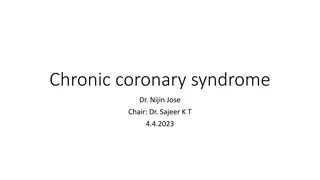Understanding Coronary Artery Bypass Graft (CABG) in Adult Nursing
Coronary Artery Bypass Graft (CABG) is a surgical procedure where a blood vessel from another part of the body is grafted onto an occluded coronary artery to bypass blockages. This procedure is less common in women compared to men and is typically indicated for severe coronary artery disease. It is essential for alleviating angina, treating stenosis, preventing heart complications, and improving overall heart health. The choice of graft type, like arterial over venous, impacts long-term outcomes. Various aspects of CABG, including vein selection, indications, and postoperative considerations, play crucial roles in patient care and recovery.
Download Presentation

Please find below an Image/Link to download the presentation.
The content on the website is provided AS IS for your information and personal use only. It may not be sold, licensed, or shared on other websites without obtaining consent from the author. Download presentation by click this link. If you encounter any issues during the download, it is possible that the publisher has removed the file from their server.
E N D
Presentation Transcript
Adult Nursing(2nd Stage) Coronary Artery Bypass Graft (CABG) (Theory) University of Basrah College of Nursing Fundamentals of Nursing Department
Coronary Artery Bypass Graft (CABG) Definition A surgical procedure in which a blood vessel from another part of the body is grafted onto the occluded coronary artery below the occlusion in such a way that blood flow bypasses the blockage University of Basrah-College of Nursing Fundamentals of Nursing Department
CABG is performed less frequently in women compared with men, women referred for this surgery tend to be older and have more comorbidities such as diabetes. In addition, they have a higher risk of surgical complications and increased mortality. Although some women have good outcomes following CABG, men generally have a better rate of graft patency and symptom relief. University of Basrah-College of Nursing Fundamentals of Nursing Department
The coronary arteries to be bypassed must have at least a 70% occlusion, or at least a 50% occlusion if in the left main coronary artery. If significant blockage is not present, flow through the artery will compete with flow through the bypass, and circulation to the ischemic area of myocardium may not improve. Arterial grafts are preferred to venous grafts because they do not develop atherosclerotic changes as quickly and remain patent longer. University of Basrah-College of Nursing Fundamentals of Nursing Department
A vein commonly used for CABG is the greater saphenous vein followed by the lesser saphenous. The vein is removed from the leg and grafted to the ascending aorta and to the coronary artery distal to the lesion. Traditionally, a skin incision was made over the length of vein segment, but new techniques allow small leg incisions. Lower extremity edema continues to be a common adverse effect of vein removal. The degree of edema varies and usually diminishes over time. The patency of vein grafts can be limited. Within 5 to 10 years, atherosclerotic changes often develop in saphenous vein grafts. University of Basrah-College of Nursing Fundamentals of Nursing Department
Major indications for CABG Alleviation of angina that cannot be controlled with medication or PCI Treatment for left main coronary artery stenosis or multi- vessel CAD Prevention of and treatment for MI, dysrhythmias, or heart failure Treatment for complications from an unsuccessful PCI University of Basrah-College of Nursing Fundamentals of Nursing Department
The recommendation for CABG is determined by a number of factors including:- Number of diseased coronary vessels. Degree of left ventricular dysfunction. Presence of other health problems. Patient s symptoms, and any previous treatment. University of Basrah-College of Nursing Fundamentals of Nursing Department
Traditional Coronary Artery Bypass Graft CABG procedures are performed with the patient under general anesthesia. In the traditional CABG procedure, the surgeon performs a median sternotomy and connects the patient to the cardiopulmonary bypass (CPB) machine. CPB maintains perfusion to body organs and tissues and allows the surgeon to complete the anastomoses in a motionless, bloodless surgical field. Next, a blood vessel from another part of the patient s is grafted distal to the coronary artery lesion, bypassing the obstruction. CPB is then discontinued, chest tubes and epicardial pacing wires are placed, and the incision is closed. The patient is then admitted to a critical care unit.
Alternative Coronary Artery Bypass Graft A number of alternative CABG techniques have been developed that may have fewer complications for some groups of patients. Off-pump coronary artery bypass (OPCAB) surgery has been used successfully in many patients. OPCAB involves a standard median sternotomy incision, but the surgery is performed without CPB. A beta-adrenergic blocker may be used to slow the heart rate. The surgeon also uses a myocardial stabilization device to hold the site still for the anastomosis of the bypass graft into the coronary artery while the heart continues to beat. University of Basrah-College of Nursing Fundamentals of Nursing Department
Complication Hypovolemia: result from loss of blood and intravascular volume Persistent bleeding: result from platelete dysfunction duo to cardiopulmonary bypass Hypothermia Hypertension: result from postoperative vasoconstriction Cardiac failure: myocardial contractility may be decreased perioperatively Acute kidney injury duo to hypoperfusion Infection University of Basrah-College of Nursing Fundamentals of Nursing Department
Nursing diagnosis Decreased cardiac output related to blood loss and compromised myocardial function. Impaired gas exchange related to chest surgery. Risk for imbalanced fluid and electrolyte related to alteration in blood volume. Acute pain related to surgery . Ineffective thermoregulation related to infection. University of Basrah-College of Nursing Fundamentals of Nursing Department
Preoperative nursing management Assesses the patient for disorders that could complicate or affect the postoperative course, such as diabetes, hypertension, and lung disease. Preoperative testing consists of a chest x-ray; ECG; laboratory tests, including coagulation studies; and blood typing and crossmatching. Obtaining baseline physiologic, psychological, and social information. Cognitive status is carefully assessed, as patients with impaired cognitive status will need more assistance after surgery and may require sub acute care prior to returning home. The patient s and family s learning needs are identified and addressed. The status of the cardiovascular system is determined by reviewing the patient s symptoms, including past and present experiences with chest pain, palpitations, dyspnea, leg pain that occurs with walking (intermittent claudication), and peripheral edema. University of Basrah-College of Nursing Fundamentals of Nursing Department
The patients history of major illnesses; previous surgeries; medication; herbal supplements, alcohol, and tobacco is also obtained. Particular attention is paid to blood glucose control in patients with diabetes because there is a higher incidence of postoperative complications when glycemic control is poor. Patients and their families are given specific instructions. This includes information on how the patient should take or stop specific medications, including anticoagulant agents, antihypertensive medications, and medications that control diabetes. The patient is instructed to shower with an antiseptic solution such as chlorhexidine gluconate. Hair removal with an electric clipper rather than a razor is used when indicated. Explains deep breathing and coughing, the use of the incentive spirometer, and foot exercises, the nurse practices these procedures with the patient. University of Basrah-College of Nursing Fundamentals of Nursing Department
Postoperative Nursing Management Initial postoperative care focuses on achieving or maintaining hemodynamic stability and recovery from general anesthesia. Care may be provided in the post anesthesia care unit (PACU) or ICU. Specific information about the surgical procedure and important factors about postoperative management are communicated by the surgical team and anesthesia personnel to the critical care or PACU nurse, who then assumes responsibility for the patient s care. After the patient s cardiac status and respiratory status are stable, the patient is transferred to a surgical progressive care unit. Care in both the ICU and progressive care unit focuses on monitoring of cardiopulmonary status, pain management, wound care, progressive activity, and nutrition. Education about medications and risk factor modification is emphasized. University of Basrah-College of Nursing Fundamentals of Nursing Department
University of Basrah-College of Nursing Fundamentals of Nursing Department























